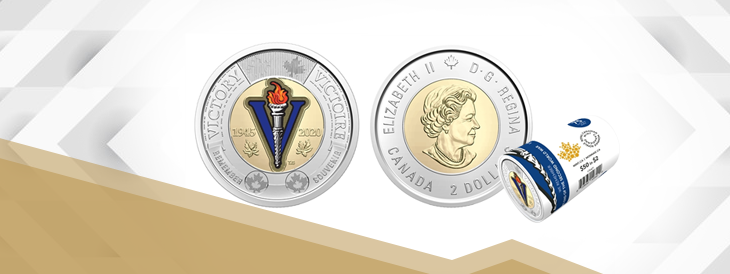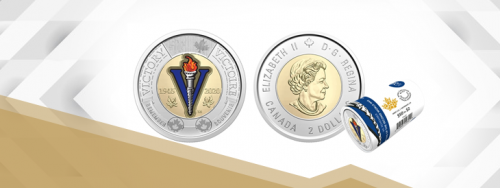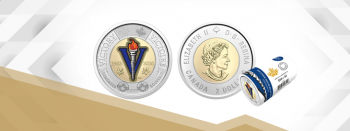Last updated on July 23rd, 2025 at 08:23 am
Last Updated on July 23, 2025 Posted by Colonial Acres Coins
The year 2020 marks the 75th anniversary of the end of World War II in 1945. The Second World War was one of the most significant and deadly conflicts in recorded history. The Royal Canadian Mint is commemorating the end of WWII and celebrating Canada’s contribution to the victory with $2 coin rolls recreating the design of the famous Victory Nickel, now in vibrant colour.
Sacrifices on the Homefront
The efforts on the homefront were as significant to the eventual victory as the military actions taking place in the European and Pacific theatres. Canadians rationed food and avoided certain foods altogether to ship overseas to Britain. Bombarded by Nazi air raids, Britain relied significantly on the imported food from Canada, including evaporated milk, cheese, eggs, bacon, and flour.
In addition to rationing food, Canadians also aided the war effort by planting victory gardens on unused plots of land, buying bonds to fund military campaigns, and giving up household items made of certain types of metal to be melted down for weapons and armour.
One of the most crucial metals needed during the war was nickel. As a result, Canadian five-cent coins were made from other metals during this time, first, a bronze alloy called tombac and later steel.
Significance of the Original Design
At the beginning of 1943, the end of the conflict was still two years away, and Canada had suffered several demoralizing defeats. That year, Thomas Shingles became the Master Engraver at the Royal Canadian Mint. He created a new temporary design for the reverse of the nickel that would help to keep up Canadian spirits on the homefront. Produced from 1943 and 1945, it came to be known as the Victory Nickel, and it was loaded with symbolism.
Featured prominently on the Victory Nickel design was a large letter V. This had a dual meaning. As V is the Roman numeral for 5, it denoted the coin’s value. However, it had a stronger association with Winston Churchill’s “V for Victory” slogan. In addition to the V was a brightly burning torch, representing the sacrifices that Canadians were making on the homefront. Around the outside edge of the coin was a series of raised symbols. Many dismissed them as mere decoration, but in fact, they spelt out a message in Morse code.
Devised in the mid-1800s, Morse code was one of the earliest forms of long-distance communication. It was used in WWII between naval bases and warships due to limitations on radio frequency and the need to prevent messages from falling into the hands of the enemy. Shingles used Morse code to spread a message of encouragement to Canadians on the homefront: “We Win When We Work Willingly.”
Updates to the Current Design
The two-dollar commemorative coin faithfully recreates Shingles’ symbolic design of the letter V and the torch. This time, however, the design is coloured with red-and-orange flames on the torch and blue for the letter V. By recreating Thomas Shingles’ initials present on the original five-cent piece, the new coin pays homage to the original artist. Shingles’ original Morse code message is recreated, and the same message has been translated into French in Morse code.
Other additions to the coin include bilingual messages describing its purpose: “Remember/Souvenir” and “Victory/Victoire.” The Allied victory over the Axis forces in World War II was possible in part because of the sacrifices of Canadians, on the homefront as well as the front lines. Remembering and honouring their sacrifices means that they were not in vain.
These 75th Anniversary commemorative coin rolls serve as a striking reminder of both the victory and the sacrifice. Not only does the custom paper wrap feature elements of the design, but the 25 coins are packaged in such a way that it is visible on either end of the roll. Select this special wrap roll from Colonial Acres Coins as a thoughtful gift or to add to your own collection.




